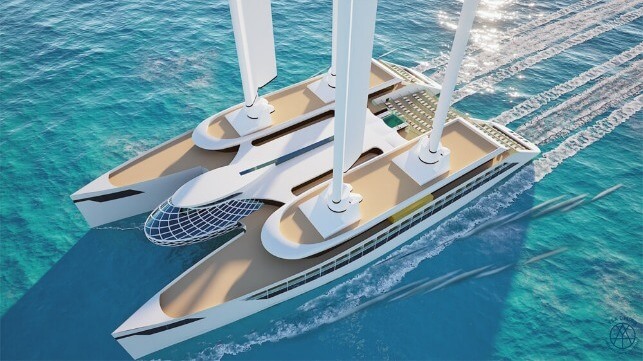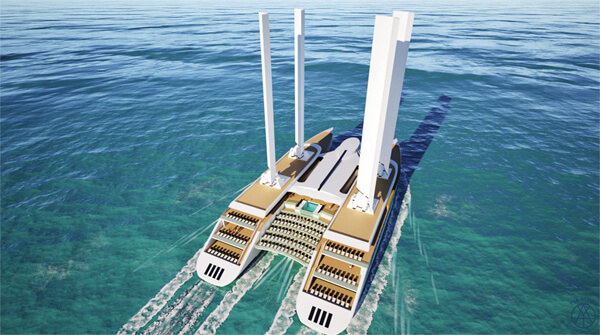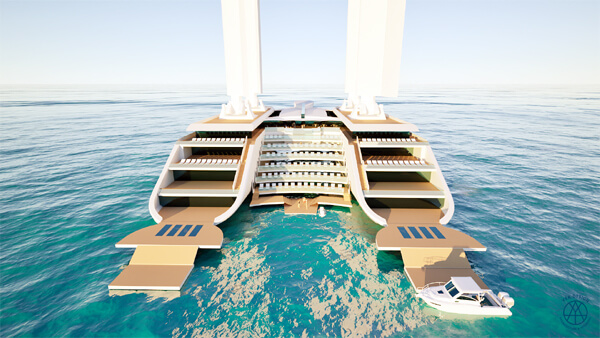YSA Uses Sails to Meet Challenge of Creating Sustainable Cruise Ship

Norwegian architecture firm YSA Design tackled the challenge of creating a sustainable cruise ship developing the concept for a luxury catamaran cruise ship with sail power. The designers looked to capture the trends in cruising creating a platform for luxury travel that provides unique experiences while also addressing the increasing attention to sustainability among travelers.
“A sustainable ship which brings environmentally conscious guests closer to the sea and reaches destinations others cannot is a clear opportunity at the premium end of the cruise market,” says Trond Sigurdsen, Senior Architect and Partner of YSA Design who also heads their Sustainability & Technology efforts. He acknowledges that there would be challenges in developing the design but that it also presents new perspectives for the market.
Sigurdsen highlights that they selected a catamaran to address the concern of maintaining a stable platform for a cruise ship. While they applied sails to the design to achieve zero emissions, he recognized that as a cruise ship, they could not develop more than a two-degree list for the comfort of the passengers. A catamaran was the natural solution for stability, but it also presents part of the uniqueness of the onboard experience.
Propulsion power is provided by 164-foot (50-meter) sails. The catamaran design provides space for a total of four of the sails. YSA selected the sail concept from Oceanbird, a joint venture launched in 2021 by Alfa Laval and Norwegian shipping company Wallenius Wilhelmsen, which has been working on the sail concept for more than a decade. Oceanbird plans land-based tests this year ahead of the installation of a prototype sail on a Wallenius Wilhelmsen vehicle carrier either in late 2024 or early 2025.

The stern decks would provide outdoor space for 70 percent of the passengers (YSA)
According to YSA, the cruise ship would be able to achieve an operating speed of 13 knots while entirely under sail power. The Oceanbird sails also fold down for the vessel to navigate in areas with restricted air clearances. The sails would each stand on a 20-foot (6-meter) base, and Sigurdsen highlights that they are computerized and easy to operate.
Further enhancing the vessel’s overall sustainability, YSA projects the engines, which would be aboard as a backup or when maneuvering, would be fueled with bio-methane. They would also assist with the power requirements of the hotel. The design would also include batteries for a hybrid drive that would permit the cruise ship to navigate and operate silently to enter environmentally sensitive areas.
The 343-foot (104.5 meter) length ship with a 13-foot (4 meter) draft would be able to access shallow waters providing unique destinations for the passengers. The two 60-foot (18.2 meter) wide hulls would be connected by an inverted U-shaped structure spanning 60 feet (18.5 meters), with a two-deck central superstructure incorporating the bridge and some public spaces. Each hull would include four decks plus a “yacht top” area that could be used for private deck areas for suite passengers. They project a total of 100 dual occupancy passenger cabins including private balconies for 200 passengers and 155 crew. It would be possible to stretch the design to accommodate 400 passengers.
Sigurdsen highlights as a catamaran, the passenger areas are suspended above the water creating the opportunity for unique viewing areas. He includes a large glass deck area, a bay (a glass bubble), and underwater hull lights for a view into the sea. The design also includes a forward-view lounge.
Other unique experiences would include folding down platforms on the stern stepping the aft decks to the sea. The aft decks would provide space for sea lounges that could open for sunset dining, be the location for spas, or a beach and watersports area.
In addition to being a zero-emission cruise ship, Sigurdsen highlights that the design helps get back to the sea. It provides passengers with experiences related to the ocean environment while knowing that their travel meets the goals for sustainability.

The stern decks could open and step down to the sea to provide passengers unique experiences and a link to the ocean environment (YSA)
No comments:
Post a Comment